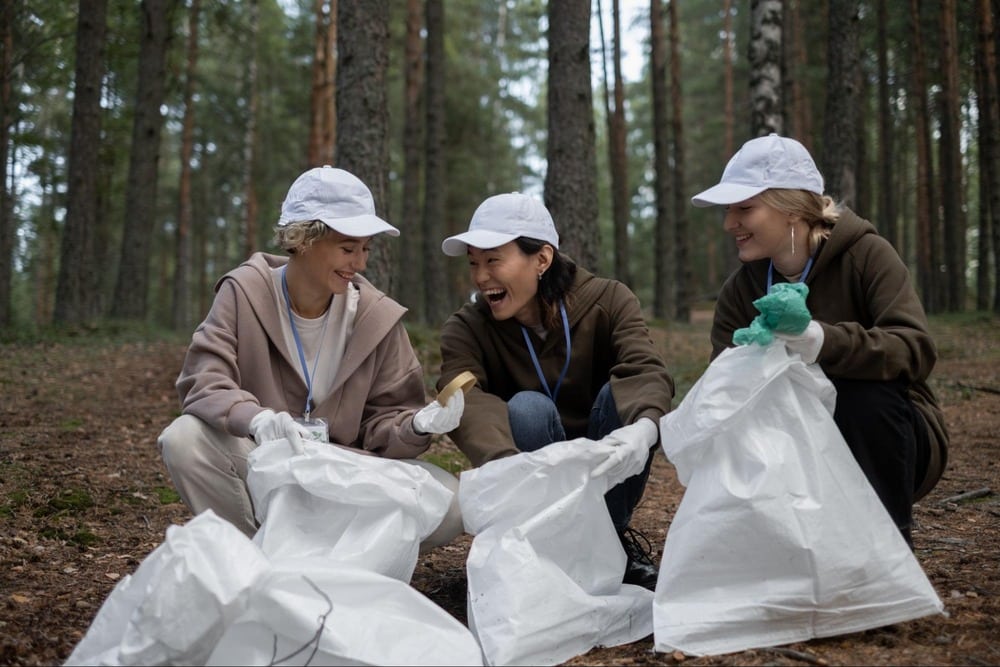What is the significance of community engagement in societal development?
In the words of Yuval Noah Harari, acclaimed author of “Sapiens: A Brief History of Humankind,” community engagement embodies the realization of humankind’s greatest power – collaboration. As Harari highlights in his book, our species’ ability to work together, form bonds, and engage collectively has been the driving force behind our remarkable progress throughout history.
Just as Homo sapiens thrived through collaboration, community engagement today remains the catalyst for societal development. This idea emphasizes that our real power is found when we join forces, share what we have, and work together to tackle difficulties as a united group.
If you are struggling to find the right idea for your next community engagement project, in this article, you’ll discover 8 community engagement ideas that cater to unique community needs and aspirations.
What is a Community Engagement Strategy?
Overview of creative engagement strategies
Creative community engagement strategies, unlike conventional approaches, which may rely on routine methods, infuse innovation and imagination into the process.
Creative approach is much better at capturing the attention of participants, and driving people’s attention in the desired direction.
It usually involves some of the innovative methods such as art installations, interactive workshops, digital campaigns. These approaches inspire genuine connections and create lasting impressions, igniting a passion for collective action and change.
Imagination is innate in all of us, and although it can seem as a play for many, it’s ultimately what can drive the change in society. Everything was first started in someone’s mind, isn’t it? However, it’s important to direct imagination to resolve the unique issues of the community.
Get inspired by some of the best community engagement examples.
How do traditional and creative community engagement methods differ?
Traditional and creative community engagement methods represent two distinct yet complementary realms, each offering unique approaches to connect with communities. Traditional methods often involve town hall meetings, surveys, door-to-door outreach, and other well-established means of gathering feedback and disseminating information.
On the other hand, effective creative community engagement projects are focusing on novel ways to inspire participation and see the same things in a different perspective. These approaches work really well when it comes to getting different and usually difficult-to-contact groups of people involved. They help bring these communities into the discussion and motivate them to participate actively.
While traditional methods often rely on conventional means of communication, creative community engagement leverages technology, multimedia, and innovative platforms to broaden the scope of interaction. By combining the strengths of both traditional and creative methods, community engagement initiatives can achieve comprehensive and inclusive outreach, ensuring that diverse voices are heard and contributing to more holistic and impactful results.
We should remember that building a community space is far more important than achieving isolated goals.
How does the Creative Forces Community Engagement Grant support the realization of your project?
How can grants support your community engagement?
Providing grants is a means of conveying to your community, “We stand with you; you are not alone on this journey.”
Community engagement grants play a critical role in supporting community engagement initiatives by providing essential financial resources. These funds offer the means to turn visionary ideas into actionable projects that positively impact communities. In 2022, the inaugural round of grants supported projects at 26 organizations totaling over $750,000 in awards. This year, the second round of grant projects are totaling over $760,000 in awards.
Click here to learn more about how to apply for Creative Forces Grants.
With the support of the Creative Forces Community Engagement Grant, your idea can take shape and make a significant impact in the community. By utilizing innovative digital platforms like Instant Input and organizing traditional town hall meetings, the grant encourages open dialog and communication, fostering inclusivity and collaboration among all members of the community.
The support of grants serves as a bridge, connecting communities with artists, creative professionals, and facilitators, ensuring that meaningful interactions and collaborations thrive.
With access to additional resources, organizations can provide much more than on their own and leverage new technologies, multimedia platforms, and innovative techniques. 17% of organizations reported migrating to a new community platform in the past 12 months, based on The Community Roundtable’s yearly State of Community Management Report. This research publication not only provides a retrospective view of industry advancements but also offers valuable insights for progress and evolution moving ahead.
What are Creative Forces Community Engagement Grants, their purpose and how to apply?
No one can do big things on their own. We need support, energy and let’s face it – money. Creative Forces Community Engagement Grants are the financial support that you can use to achieve your ideas and make an impact in military communities.
Anyone who’s interested, both individuals and organizations, can apply for Creative Forces Community Engagement Grants, by submitting a detailed proposal. The proposal includes an outline of their project’s vision, objectives, and intended impact on military communities.
Deep dive to discover how to engage community members with ideas for community engagement.
Here you can learn more about making a positive impact with Civic Engagement.
Top 8 Creative Community Engagement Ideas
If you need help with community engagement ideas and building a community engagement strategy, keep reading. We’ll cover all the basics of community engagement, and how to organize community engagement events step by step, including 8 creative community engagement activities.
Idea #1: Sustainable Community Gardening

Sustainable community gardening is all about people in a neighborhood working together to make eco gardens. These gardens are like little parks where everyone can plant and take care of fruits, veggies, and flowers without using harmful stuff.
Step 1. Identify Suitable Locations: Discover available spaces within the community, such as vacant lots, parks, or unused land, that can be transformed into community gardens. See local government officials and property owners as potential collaborators for this project. They are also the ones that need to give permission for the project.
Step 2. Form a Community Garden Committee: Establish a committee comprising dedicated community members, gardening enthusiasts, and experts in sustainable agriculture. This team will be in charge of making plans, getting things organized, and taking care of the community garden over time.
Step 3. Organize Educational Workshops: Offer regular workshops on gardening, sustainable practices, and food preservation to educate community members and enhance their gardening skills. These workshops empower individuals to adopt sustainable practices in their own homes.
Step 4. Create Strong Community Bonds: Work together with nearby schools, companies, and groups to get them engaged and backing the community garden. By teaming up, we can make the garden’s influence even greater and connect with people who share similar interests.
Idea #2: Organize an Open Discussion Group

An open discussion group is like a cool gathering where people from a community can chat and share their ideas about different things.
To implement this idea successfully, consider the following steps:
Step 1. Identify Relevant Topics: Begin by identifying relevant topics that resonate with the community’s interests, concerns, and goals. Anything related to local issues, global affairs, personal development, or any subject that encourages thoughtful discussion.
Step 2. Set Clear Objectives: Establish clear objectives for the open discussion group. Outline the purpose, expected outcomes, and the type of constructive engagement you hope to foster among participants.
Step 3. Appoint a Facilitator: Designate a skilled and neutral facilitator to guide the discussions effectively.
Step 4. Provide Background Information: Offer background information on the chosen topics before the discussions to ensure all participants have a basic understanding of the subject matter. This allows for more informed and thoughtful exchanges.
Step 5. Document and Reflect: Record key takeaways and insights from each discussion to document the progress and identify areas for further exploration. Share these reflections with the community to maintain transparency and continuity.
Instant Input is like a tool that helps people in a community share their thoughts and ideas. It lets them join in conversations, talk about things, and also keeps them updated about what’s happening in the community. This way, everyone feels like they’re part of the group and they belong there.
Here you can learn how to build an inclusive community.
Idea #3: Run a Photo Challenge

Initiate a content challenge where community members are encouraged to take photos of their city/village based on a theme. Showcase the submissions on your community platform and let members vote for their favorites.
By displaying the submissions on your community platform and encouraging members to vote for their favorites, you foster a sense of participation, appreciation, and celebration of unique perspectives.
Here’s how you can organize the Photo Challenge:
Step 1. Define the Theme or Prompt: Set a compelling theme or prompt that resonates with your community’s interests and values. Themes can range from seasonal delights and cultural celebrations to community-related topics.
Step 2. Set Clear Guidelines: Establish guidelines for submissions, specifying the format, size, and any other relevant requirements to ensure a level playing field for all participants.
Step 3. Create a Submission Platform: Set up an accessible platform for participants to submit their content, such as a dedicated website, social media hashtag, or an online form.
Step 4. Encourage Community Interaction: Foster interaction and support among participants by creating a space for them to comment, like, and share their favorite submissions.
Step 5. Display Submissions: Showcase the submissions on your community platform, ensuring that each creative work receives the recognition it deserves.
Step 6. Implement Voting Mechanism: Allow community members to vote for their favorite entries. This voting process can be public or anonymous, depending on your community’s preferences. Announce the winners and celebrate their creative achievements. Offer recognition, certificates, or small rewards to show appreciation for their outstanding contributions.
Overcome the challenges of starting the first community engagement project with the help of Instant Input.
Idea #4: Organize a Discussion to Learn About Your City’s History

Imagine setting up a talk or gathering where people can come together to talk and learn about the past. We all make part of a bigger picture, and learning about history can help us feel connected and understand our current position.
Here’s how you can organize a discussion to explore and celebrate the history of your city:
Step 1. Identify Relevant Topics: Research key historical events, landmarks, and prominent figures that shaped your city’s identity. Create a list of topics that reflect significant milestones and periods worth discussing.
Step 2. Gather Historical Materials: Collect photographs, documents, maps, and any other historical materials that can serve as visual aids during the discussion. These resources will help participants visualize the city’s past and make the session more engaging.
Step 3. Invite Knowledgeable Speakers: Reach out to local historians, experts, or individuals with firsthand knowledge of the city’s history. Inviting knowledgeable speakers can add depth and authenticity to the discussion, ensuring accurate information is shared.
Step 4. Promote Community Participation: Encourage community members to actively participate in the discussion. Allow time for questions, personal anecdotes, and sharing family stories related to the city’s history.
Idea #5: Collaborative Storytelling Project

Initiate a community-wide storytelling project where each member adds a sentence or paragraph to a shared story. The story can be based on a central theme or genre. This collaborative effort encourages creativity, cooperation, and the development of a unique narrative collectively crafted by the community.
How to Organize the Collaborative Storytelling Project:
Step 1. Choose a Central Theme or Genre: Set a central theme or genre for the story to provide a cohesive framework. Whether it’s a thrilling adventure, a heartwarming tale of friendship, or an exploration of fantasy realms, a common focus will guide participants in their storytelling.
Step 2. Establish a Platform: Select a user-friendly platform where community members can easily contribute to the story. This could be a dedicated website, a shared document, or a collaborative writing tool.
Step 3. Promote Inclusivity: Encourage all community members, regardless of age or background, to participate. This project welcomes storytellers of every skill level, ensuring that diverse voices enrich the narrative.
Step 4. Initiate the Story: Kick off the storytelling project with an engaging opening paragraph that captures the essence of the chosen theme or genre. Provide a starting point that leaves room for imagination and invites various story directions.
Step 5. Share Guidelines: Set clear guidelines to maintain a coherent storyline. Participants should build on previous contributions while respecting the established plot and characters.
Step 6. Set a Timeline: Establish a timeline for the project, allowing enough time for members to contribute thoughtfully. Regular updates and reminders will keep the momentum going.
Ready to foster inclusivity in your community? Try Instant Input today and start the transformation.
Idea #6: Street Art Projects

Imagine local artists teaming up with people from the neighborhood to turn boring blank walls and old buildings into vibrant, colorful murals.
Here’s how you can bring this idea to life:
Step 1. Gain Community Support: Begin by seeking support and buy-in from community members, local businesses, and government authorities. Engage in discussions and presentations to showcase the benefits of street art in enhancing public spaces and fostering community pride.
Step 2. Identify Suitable Locations: Scout for potential locations within the community that could benefit from street art interventions. These areas might include blank walls, underpasses, neglected buildings, or even public plazas that could be enlivened through artistic transformation.
Step 3. Collaborate with Artists: get in touch with local artists, mural painters, and folks who love street art. Ask them if they’d like to team up with you. You can tell them about your idea and invite them to share their own ideas too.
Step 4. Secure Permissions: Obtain the necessary permits and approvals from relevant authorities to ensure the legality and sustainability of the street art project.
Step 5. Involve the Community: Encourage community members of all ages to actively participate in the street art project by organizing workshops, art contest or similar events.
Step 6. Showcase Local Stories: Use street art as a canvas to showcase local stories, legends, or historical events that resonate with the community’s identity.
Idea #7: Theater in the Park

Organizing free open-air theater performances in local parks or community centers not only provides entertainment but also addresses important social issues, sparking conversations and engagement among the audience.
Step 1. Start with detailed planning. It means working closely with artists, coming up with plans, and involving the community to make a special theater show that everyone will remember. And all of this happens outside, under the open sky. Here are the steps to implement :
Step 2. Choose the Location: Select a suitable park or outdoor space with ample seating and good visibility to accommodate the audience comfortably. Ensure that the chosen location is accessible and aligns with the community’s preferences.
Step 3. Obtain Permits and Permissions: Check with local authorities to secure the necessary permits for hosting a public event in the park. This includes permits for sound amplification, temporary structures, and any other requirements.
Step 4. Collaborate with Theatre Groups: Partner with local theater groups, drama clubs, or professional artists to bring their talent to the outdoor stage. Engage in discussions to finalize the production and seek their creative input.
Step 5. Set a Date and Time: Choose a date and time that complements the weather conditions and provides sufficient daylight for the performance. Consider hosting matinee and evening shows to cater to a broader audience.
Step 6. Arrange Seating and Facilities: Arrange seating options such as blankets or chairs to accommodate the audience. Provide basic facilities like restrooms and refreshment stands to enhance the overall experience.
Step 7. Capture the Moment: Arrange for professional videography or photography to capture the Theatre in the Park event. Share these moments on community platforms and social media to extend the impact beyond the event itself.
Ready to make an impactful social involvement plan? Get started now with Instant Input surveys!
Idea #8: Organize a Clean-Up Initiative

Organizing a Clean Day is an impactful community initiative that rallies members together to take collective action in improving the cleanliness and environmental health of their surroundings.
To implement this idea effectively, consider the following steps:
Step 1. Establish a Planning Committee: Create a planning committee comprising enthusiastic community members, local organizations, and representatives from relevant authorities. This diverse group will lead the coordination and execution of the Clean Day.
Step 2. Choose a Suitable Date: Select a date for the Clean Day that aligns with the community’s availability and favorable weather conditions. Consider weekends or public holidays to maximize participation.
Step 3. Identify Target Areas: Survey the community to identify areas that require cleaning and improvement. Prioritize spaces that are heavily littered or neglected.
Step 4. Secure Permissions: If necessary, obtain necessary permissions and approvals from local authorities or property owners to conduct the clean-up activities in public spaces.
Step 5. Mobilize Volunteers: Engage the community by promoting the Clean Day through social media, posters, flyers, and local media channels. Encourage residents, schools, businesses, and community groups to volunteer for the event.
Step 6. Arrange Necessary Supplies: Organize cleaning equipment, such as trash bags, gloves, brooms, and litter pickers, to distribute among the volunteers. Consider partnering with local businesses or sponsors for additional support.
Step 7. Collaborate with Waste Management: Coordinate with waste management services to arrange for proper waste disposal or recycling of collected trash after the Clean Day.
Step 8. Celebrate and Appreciate: After the Clean Day, celebrate the community’s achievements and express gratitude to all participants. Share the results and impact of the event through social media and community platforms.
It’s time to take the next step and learn how to create a community engagement plan. It all starts with an idea, but before an idea becomes reality, a community engagement strategy should take place.
Community at the Heart of Your Ideas
“There is no power for change greater than a community discovering what it cares about.” – Margaret J. Wheatley
All your ideas should start with the community, and all the benefits should end with the community.
When brainstorming the ideas for your next or first community engagement, you should always bear in mind who your community is and how the project can benefit them. A few more questions could also help you when coming up with an idea for your community project. If you wish to create an effective community engagement strategy, ask yourself:
- Who are the people you are addressing with your project?
- What are their passions and pains?
- What is the best way to connect with them?
- What project can turn into an ongoing activity within the community?
Community engagement is more than just generating buzz; it is a genuine commitment to connect, whether that’s an online community or not, listen, and involve your audience. If you can keep your community at the forefront of everything you do, you’re more likely to have success with your community engagement strategy and find effective community engagement ideas.
From using innovative digital platforms like Instant Input to traditional town hall meetings, you’ll find everything you need to kickstart your community project. If you need help to inspire the best in your community, try out the app that makes community engagement easy and effective.
Ready to make a contribution to your own community?
FAQs
What are some community engagement activities?
Community engagement activities can include events, workshops, surveys, open discussions, volunteering, and collaborative projects.
How do you stimulate community engagement?
Community engagement can be stimulated through effective communication, active involvement of community members, providing opportunities for input and feedback, and fostering a sense of belonging.
What are the four pillars of community engagement?
The four pillars of community engagement are communication, collaboration, participation, and empowerment.
What are examples of community based activities?
Examples of community-based activities include community clean-ups, neighborhood watch programs, food drives, cultural festivals, and educational workshops.
What are the four core values of an effective community engagement strategy?
The four core values of community engagement are inclusivity, transparency, accountability, and respect for diverse perspectives.
What is a community engagement strategy?
A community engagement strategy is a comprehensive plan developed by organizations, governments, or individuals to actively involve and collaborate with members of a community. It aims to foster open dialog, build trust, and create meaningful connections with community members to address their needs, concerns, and aspirations effectively.